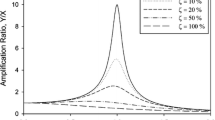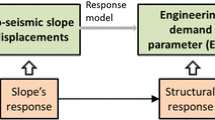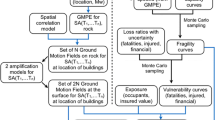Abstract
Natural gas production in the Groningen field in the Netherlands is causing induced earthquakes that have raised concerns regarding the safety of the local population given that the exposed building stock (which is predominantly unreinforced masonry residential housing) has not been designed and constructed considering seismic loading. Significant effort has been invested to date in assessing the safety risk of these buildings within a probabilistic framework. This paper describes the efforts that have since been made to extend this framework for probabilistic damage assessment of the buildings, for slight non-structural, slight structural and moderate structural damage. Fragility functions for non-structural damage have been developed considering the observed damage from damage reports, rather than from damage claims due to a number of issues with the latter, as described herein. Structural damage has been estimated using analytical models that have been calibrated through extensive in situ data collection and experimental testing. The probabilistic damage assessment is presented in terms of F-N curves, which plot the annual frequency of exceedance against number of buildings reaching each damage state.




(note the location of Groningen city has been signalled in both plots to aid comparison)










Similar content being viewed by others

References
Ahmad N, Crowley H, Pinho R (2011) Analytical fragility functions for reinforced concrete and masonry buildings and buildings aggregates of euro-Mediterranean regions—UPAV methodology. Internal Report, Syner-G Project 2009/2012
Arup (2017) Typology modelling: analysis results in support of fragility functions—2017 batch results. 229746_031.0_REP2005, NAM Platform, November 2017
Arup (2018) Data Documentation EDB V5. 229746_052.0_REP2014, Rev.0.09 ISSUE_DEF, NAM Platform
Arup, TU Delft, Eucentre (2015) Eucentre shake-table test of terraced house modelling predictions and analysis cross validation. NAM Platform, November 2015
Arup, TU Delft, Eucentre, Arcadis (2016a) EUC-BUILD2: modelling predictions and analysis cross validation of detached single-storey URM building. NAM Platform September 2016
Arup, TU Delft, Eucentre (2016b) Laboratory component testing: modelling post-test predictions and analysis cross validation. NAM Platform, February 2016
Arup, TU Delft, Eucentre, Mosayk (2017) LNEC-BUILD1: modelling predictions and analysis cross validation. NAM Platform, September 2017
ASI (2017) Extreme loading for structures v5. Applied Science International LLC, Durham
Avanes C, Fusco C, Mooneghi MA, Huang Y, Palmieri M, Sturt R (2018a) LS-DYNA numerical simulation of full scale masonry cavity wall terraced house tested dynamically. In: Proceedings of the 16th European conference in earthquake engineering, paper no. 10342, Thessaloniki
Avanes C, Montalbini G, Huang Y, Sturt R, Palmieri M (2018b) LS-DYNA numerical simulation of solid unreinforced masonry detached house tested dynamically. In: Proceedings of the 16th European conference in earthquake engineering, paper no. 10343, Thessaloniki
Bommer JJ, Alarcón JE (2006) The prediction and use of peak ground velocity. J Earthq Eng 10(1):1–31
Bommer J, Crowley H, Pinho R (2015) A risk-mitigation approach to the management of induced seismicity. J Seismolog 19:623–646
Bommer J, Stafford PJ, Ntinalexis M (2016) Empirical ground-motion prediction equations for peak ground velocity from small-magnitude earthquakes in the Groningen field using multiple definitions of the horizontal component of motion, NAM Platform, November 2016
Bommer JJ, Stafford PJ, Ntinalexis M (2017a) Empirical ground-motion prediction equations for peak ground velocity from small-magnitude earthquakes in the Groningen field using multiple definitions of the horizontal component of motion, NAM Platform, November 2017
Bommer JJ, Stafford PJ, Edwards B, Dost B, van Dedem E, Rodriguez-Marek A, Kruiver P, van Elk J, Doornhof D, Ntinalexis M (2017b) Framework for a ground-motion model for induced seismic hazard and risk analysis in the Groningen gas field, The Netherlands. Earthq Spectra 33(2):481–498
Bommer JJ, Edwards B, Kruiver P, Rodriguez-Marek A, Stafford PJ, Dost B, Ntinalexis M, Ruigrok E, Spetzler J (2018) v5 ground-motion model for the Groningen field. Revision 1. NAM Platform
Borzi B, Crowley H, Pinho R (2008) Simplified pushover-based earthquake loss assessment (SP-BELA) method for masonry buildings. Int J Archit Herit 2(4):353–376
Bourne SJ, Oates SJ (2017) Extreme threshold failures within a heterogeneous elastic thin-sheet account for the spatial–temporal development of seismicity induced by fluid extraction from a subsurface reservoir, Submitted to J Geophys Res Solid Earth
Bourne SJ, Oates SJ, Bommer JJ, Dost Β, van Elk J, Doornhof D (2015) A Monte Carlo method for probabilistic seismic hazard assessment of induced seismicity due to conventional gas production. Bull Seismol Soc Am 105(3):1721–1738
Brunesi E, Peloso S, Pinho R, Nascimbene R (2018a) Cyclic testing and analysis of a full-scale cast-in-place reinforced concrete wall–slab–wall structure. Bull Earthq Eng. https://doi.org/10.1007/s10518-018-0374-0
Brunesi E, Peloso S, Pinho R, Nascimbene R (2018b) Cyclic testing of a full-scale two-storey reinforced precast concrete wall–slab–wall structure. Bull Earthq Eng. https://doi.org/10.1007/s10518-018-0359-z
Brunesi E, Peloso S, Pinho R, Nascimbene R (2018c) Shake-table testing of a full scale two-story precast wall–slab–wall structure. Submitted to Earthq Spectra
Brzev S, Scawthorn C, Charleson AW, Allen L, Greene M, Jaiswal K, Silva V (2013) GEM Building Taxonomy Version 2.0. GEM Technical Report 2013-02 V1.0.0, GEM Foundation, Pavia. https://doi.org/10.13117/gem.ext-mod.tr2013.02
BSI (1993) Evaluation and measurements for vibration in buildings—part 2: guide to damage levels due to groundborne vibrations. BS 7385-2, British Standards Institute
Casarotti C, Pinho R (2007) An adaptive capacity spectrum method for assessment of bridges subjected to earthquake action. Bull Earthq Eng 5:377–390
Correia AA, Tomassetti U, Campos Costa A, Penna A, Magenes G, Graziotti F (2018) Collapse shake-table test on a URM-timber roof structure. In: Proceedings of the 16th European conference on earthquake engineering, paper no. 11929, Thessaloniki
Crowley H, Pinho R (2017) Report on the v5 fragility and consequence models for the Groningen field. NAM Platform, October 2017
Crowley H, Polidoro B, Pinho R, van Elk J (2017) Framework for developing fragility and consequence models for inside local personal risk. Earthq Spectra 33(4):1325–1345
Dost B, van Eck T, Haak H (2004) Scaling of peak ground acceleration and peak ground velocity recorded in the Netherlands. Boll Geofis Teorica ed Appl 45(3):153–168
Dost B, Edwards B, Bommer JJ (2018) The relationship between M and ML—a review and application to induced seismicity in the Groningen gas field, the Netherlands. Seismol Res Lett 89(3):1062–1074
Dymiotis C, Kappos AJ, Chryssanthopoulos MK (1999) Seismic reliability of RC frame with uncertain drift and member capacity. J Struct Eng 125(9):1038–1047
FEMA (2004) HAZUS-MH Technical Manual. Federal Emergency Management Agency, Washington
Graziotti F, Rossi A, Mandirola M, Penna A, Magenes G (2016a) Experimental characterization of calcium-silicate brick masonry for seismic assessment. In: Proceedings of the 16th international brick and block masonry conference (IBMAC), Padua, Italy, pp 1619–1627
Graziotti F, Tomassetti U, Penna A, Magenes G (2016b) Out-of-plane shaking table tests on URM single leaf and cavity walls. Eng Struct 125:455–470
Graziotti F, Tomassetti U, Kallioras S, Penna A, Magenes G (2017a) Shaking table test on a full scale URM cavity wall building. Bull Earthq Eng 15(12):5329–5364
Graziotti F, Tomassetti U, Penna A, Magenes M (2017b) Tests on URM clay and calcium-silicate masonry structures: identification of damage states. Eucentre Foundation, Pavia. Working Version of October 2017. www.eucentre.it/nam-project
Graziotti F, Tomassetti U, Sharma S, rottoli L, Magenes G (2018) Experimental response of URM single leaf and cavity walls in out-of-plane two-way bending generated by seismic excitation. Constr Build Mater, accepted for publication
Grunthal G, Musson RMW, Schwarz J, Stucchi M (1998) European Macroseismic Scale 1998. Centre Europeen de Geodynamique et de Seismologie, ISBN No2-87977-008-4
Jalayer F (2003) Direct probabilistic seismic analysis: implementing non-linear dynamic assessments. Ph.D. Dissertation, Stanford University
Kallioras S, Guerrini G, Tomassetti U, Marchesi B, Penna A, Graziotti F, Magenes G (2018) Experimental seismic performance of a full-scale unreinforced clay-masonry building with flexible timber diaphragms. Eng Struct 161:231–249
LSTC—Livermore Software Technology Corporation (2013) LS-DYNA—a general-purpose finite element program capable of simulating complex problems. Livermore
Luco N, Cornell CA (2007) Structure-specific scalar intensity measures for near-source and ordinary earthquake ground motions. Earthq Spectra 23(2):357–392
Malomo D, Pinho R, Penna A (2018a) Using the applied element method to model calcium-silicate brick masonry subjected to in-plane cyclic loading. Earthq Eng Struct Dyn 47:1610–1630
Malomo D, Comini P, Pinho R, Penna A (2018b) The applied element method and the modelling of both in-plane and out-of-plane response of URM walls. In: Proceedings of the 16th European conference in earthquake engineering, paper no. 10691, Thessaloniki
Malomo D, Pinho R, Penna A (2018c) Using the applied element method to simulate the dynamic response of full-scale URM houses tested to collapse or near-collapse conditions. In: Proceedings of the 16th European conference in earthquake engineering, paper no. 10692, Thessaloniki
McKenna F, Fenves GL, Scott MH, Jeremic B (2000) Open system for earthquake engineering simulation (OpenSees). Pacific Earthquake Engineering Research Center, University of California, Berkeley
Montalbini G, Avanes C, Alessi C, Huang Y, Palmieri M, Stuart R (2018) Numerical simulation of reinforced concrete tunnel-built structure tested bi-directionally under quasi-static cyclic loading. In: Proceedings of the 16th European conference in earthquake engineering, paper no. 10272, Thessaloniki
Mosayk (2014) Software verification against experimental benchmark data. NAM Platform, November 2014
Mosayk (2015) Structural modelling of non-URM buildings—v2 risk model update. NAM Platform, October 2015
Mosayk (2017) Nonlinear dynamic analysis of index buildings for v5 fragility and consequence models. NAM Platform, October 2017
NAM (2016) Technical Addendum to the Winningsplan Groningen 2016, Part V Damage and Appendices, NAM Platform, April 2016
NAM (2017) Methodology prognosis of building damage and study and data acquisition plan for building damage. NAM Platform, February 2017
SBR (2017) SBR Trillingsrichtlijn A: Schade aan bouwwerken:2017. SBRCURnet, Delft November 2017
Seismosoft (2017) SeismoStruct v2016—a computer program for static and dynamic nonlinear analysis of framed structures. http://www.seismosoft.com
Sharma S, Tomassetti U, Grottoli L, Graziotti F (2018) Out-of-plane two-way bending shaking table tests on single leaf and cavity walls. Report n. EUC137/2018U, Eucentre Foundation, Pavia, Italy. Available from NAM Platform
Stafford PJ (2008) Conditional prediction of absolute durations. Bull Seismol Soc Am 98(3):1588–1594
Stafford PJ, Zurek BD, Ntinalexis M, Bommer JJ (2018) Extensions to the Groningen ground-motion model for seismic risk calculations: component-to-component variability and spatial correlation. Bull Earthq Eng, this issue
TNO (2009) Kalibratiestudie schade door aardbevingen, TNO-034-DTM-2009-04435
Tomassetti U, Correia AA, Graziotti F, Marques AI, Mandirola M, Candeias PX (2017) Collapse shaking table test on a URM cavity wall building representative of a Dutch terraced house. Eucentre Foundation, Pavia, Italy and LNEC, Lisbon, Portugal, September 2017
Uilenreef J, van Elk J, Mar-Or A (2018) Assessment of building damage based on production scenario “Basispad Kabinet” for the Groningen field. NAM Platform
van Elk J, Doornhof D (2017) Assessment of hazard, building damage and risk. NAM Platform, November 2017
van Elk J, Doornhof D, Bommer JJ, Bourne SJ, Oates SJ, Pinho R, Crowley H (2017) Hazard and risk assessments for induced seismicity in Groningen. Neth J Geosc 96(5):s259–s269
Acknowledgements
The authors are grateful to TNO for providing access to the geo-referenced damage data, and special thanks are due to Chris Geurts and Huibert Borsje. The Groningen probabilistic seismic hazard and risk model described herein has been developed in collaboration with Julian Bommer, Stephen Bourne and Steve Oates, whose contributions to the study presented herein, through data contribution, model checking and many fruitful discussions, are thus gratefully acknowledged. Many of the details of the fragility model described in this paper were presented to an Assurance Panel comprising Jack Baker, Ihsan Engin Bal, Matjaz Dolsek, Paolo Franchin, Ron Hamburger, Nico Luco, Markus Schotanus and Dimitrios Vamvatsikos, whose valuable feedback and recommendations are thus gratefully acknowledged. Discussions, at different stages of this work, with Guido Magenes, Raphael Steenbergen, Peter Stafford, Iunio Iervolino, Francesco Graziotti, and Andrea Penna, were also very beneficial. Further, the contributions of the exposure model team at Arup, of the field/laboratory testing team at Eucentre, and of the structural modelling teams at Arup, Eucentre and Mosayk, are gratefully acknowledged. The authors would finally like to thank the two anonmymous reviewers for their constructive comments which helped improve the clarity of this manuscript.
Author information
Authors and Affiliations
Corresponding author
Rights and permissions
About this article
Cite this article
Crowley, H., Pinho, R., van Elk, J. et al. Probabilistic damage assessment of buildings due to induced seismicity. Bull Earthquake Eng 17, 4495–4516 (2019). https://doi.org/10.1007/s10518-018-0462-1
Received:
Accepted:
Published:
Issue Date:
DOI: https://doi.org/10.1007/s10518-018-0462-1



